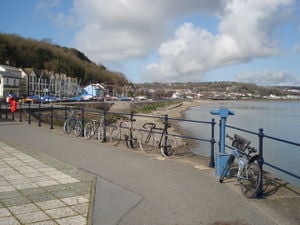Swansea community action

The aim of this page is to recognise, celebrate and encourage the self-empowerment of community agency networks (CANs) and community groups' activism for climate, environment and many other sustainability topics across Swansea.
Networks and sustainability initiatives[edit | edit source]
- The Environment Centre, Swansea, (Wikipedia) independent charity organisation for environmental information, education and activity. The Environment Centre's aims are to raise people's awareness of environmental issues, to increase the participation in environmental projects and to work towards a more sustainable future. It promotes, for example, the concept of the three Rs (reduce, reuse, recycle). The Centre provides support for environmental organizations and groups, information on environmental issues and educational activities. Both, the charity organisation and its building, serve as a central place of exchange and networking for environmental organizations all around Swansea and South Wales.
- Sustainable Swansea, Swansea Sustainability Trail, Sustainable Swansea
Environment quality[edit | edit source]
Open spaces[edit | edit source]
Friends of Bryn y Don Park on facebook
Cycling activism[edit | edit source]
There are four dedicated cycle routes in the local authority's area:
- Swansea Bay: The Maritime Quarter to the Knab Rock near the Mumbles Pier.
- Clyne Valley Country Park: Blackpill to Gowerton forming part of National Cycle Network (NCN) Route 4.
- Along the east bank of the River Tawe forming the start of NCN, Route 43, which terminates at Abercraf. Sustrans advise that it will continue northwards to Builth Wells once complete.
- Adjacent to the Fabian Way: Forming part of NCN Route 4 and extending as the Celtic Trail to Chepstow and London.
City cruiser pedal vehicles are being introduced to the city centre in a joint venture between the council and Swansea Business Improvement District.
In November 2007, a new bridge was completed over the Fabian Way which provides a one way park and ride bus lane and a shared-use pedestrian and NCN route 4 cycleway. The leaf-shaped bridge was shortlisted for the 2008 British Constructional Steelwork Association Structural Steel Design Awards.
Education for sustainability[edit | edit source]
Down to Earth, not-for-profit organisation doing innovative outdoor experiences with vulnerable and 'hard to reach' groups of all ages
Swansea Environmental Education Forum
Ethical consumerism[edit | edit source]
News archive[edit | edit source]
2010-2015
- Consent for world's first Tidal Lagoon Power Plant, June 9, 2015...Tidal Lagoon Swansea Bay
- Tidal Lagoon Swansea Bay: the mastering of the tide, August 6, 2014...Blue and Green Tomorrow
- Swansea to join thousands of other communities across the globe taking part in Earth hour 2010. "Switch off your lights for Earth's sake on March 27, 8.30pm...City and County of Swansea, February, 2010.
Maps[edit | edit source]
Green Maps, Sustainable Swansea
About Swansea[edit | edit source]
Past events
- November 21 - 22, 2015, Swansea's annual Green Fayre
Swansea ( SWON-zee; Welsh: Abertawe [abɛrˈtawɛ]) is a coastal city and the second-largest city of Wales. It forms a principal area, officially known as the City and County of Swansea (Welsh: Dinas a Sir Abertawe).
External links
References